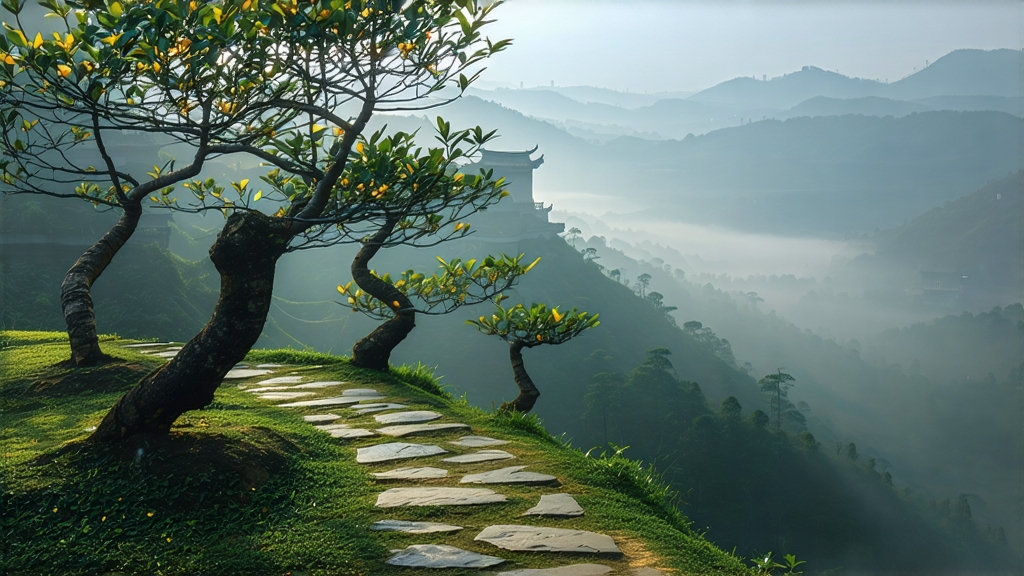
High in the folds of Sichuan’s mist-laced Meng Ding Mountains, where clouds brush the shoulders of Tang-dynasty stone steps, a tea once reserved for emperors still unfurls its golden down each March. Meng Ding Huang Ya—“the yellow bud from Meng Ding”—is the least-known yet most aristocratic member of China’s yellow-tea family. While green tea’s freshness and pu-erh’s post-fermentation grab headlines, Meng Ding Huang Ya survives as a quiet custodian of Song-era court taste, a flavor that was already ancient when Dutch merchants first tasted Chinese leaf.
Historical records kept by the Meng Ding monastery describe a spring ritual of 360 virgin buds plucked before Qingming festival, carried in bamboo tubes padded with orchid petals down the 7,200-step cliff path to Chengdu, then raced by relay horses to Chang’an. Only after the buds passed the “three-whites” test—white down, white stem tip, white frost on the leaf surface—were they sealed with camphor wax and presented to the throne. During the Northern Song, Emperor Huizong, himself a tea connoisseur, elevated Meng Ding Huang Ya to first-grade tribute, exchanging ten jin of the tea for one jade seal. When the Ming dynasty simplified tribute categories, the tea vanished from court logs, retreating into monastic gardens where monks preserved its micro-fermentation craft in scrolls hidden inside Buddha statues. Thus, for four centuries, Meng Ding Huang Ya survived as oral memory rather than commodity.
Botanically, the cultivar is a local variant of Camellia sinensis var. sinensis known to villagers as “xiao ye zhong” (small-leaf race). Grown between 800 m and 1,400 m, the bushes sit in a perpetual cloud belt that shortens sunlight to four diffuse hours daily, forcing the plant to synthesize more theanine and fewer catechins. The result is a natural umami sweetness rarely found in other yellow teas. Unlike Huo Shan Huang Ya or Jun Shan Yin Zhen, Meng Ding Huang Ya is picked as a single unopened bud with an adjacent half-open leaf, a standard called “one flag, one spear.” The ideal pluck must weigh 0.35 g, contain at least 7 mm of downy tip, and snap with a sound likened to “mountain bamboo cracking.” Experienced pickers finish before 9 a.m., when dew still acts as a protective film against oxidation.
The hallmark of yellow tea is its “sealed yellowing” (men huang) phase, a slow enzymatic oxidation that borrows from both green and black tea logics yet belongs to neither. At Meng Ding, the process is still performed in a 300-year-old monk-built chamber called “wen huang jian” (warm yellow room). Fresh leaves are first wok-fired at 180 °C for four minutes, a step called sha qing that deactivates 85 % of polyphenol oxidase while leaving a residual 15 % alive. Immediately the leaves are wrapped in steamed Meng bamboo sheaths—chosen for its neutral grass aroma—and stacked in pyramids of 2.5 kg per bundle. Over the next 72 hours, artisans flip the bundles every three hours, allowing trapped moisture and heat to coax a gentle oxidation that turns the leaf margin a primrose yellow. Temperature is never allowed above 34 °C; higher would push the tea toward black, lower would trap green astringency. On the third dawn, the master opens one bundle, inhales, and listens: a chestnut-honey note should ride above the sound of leaves rustling like silk. If both criteria are met, the tea moves to the final low-charcoal roasting; if not, the batch is demoted to mountain-green grade.
Roasting uses local Qing-gang wood that burns with a blue flame and minimal resin. Leaves are tumbled in a bamboo drum whose inner wall is lined with thin cotton; the cotton prevents direct scorching yet transmits enough heat to fix the yellow pigments. Drum speed is regulated by a foot pedal—eight seconds per revolution—while the roaster constantly smells the leaf surface, stopping when a “cooked corn milk” aroma appears. After cooling on hemp cloth, the finished tea contains 6 % moisture, curls into tiny hooks the color of antique ivory, and bears a downy underside that sparkles under light like frost on late-autumn grass.
To brew Meng Ding Huang